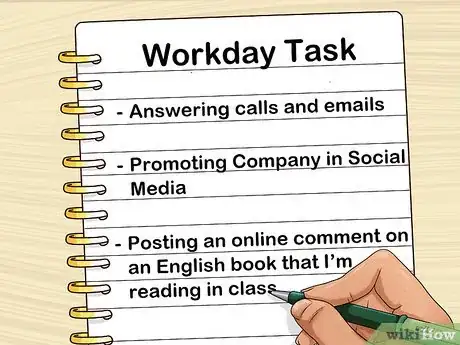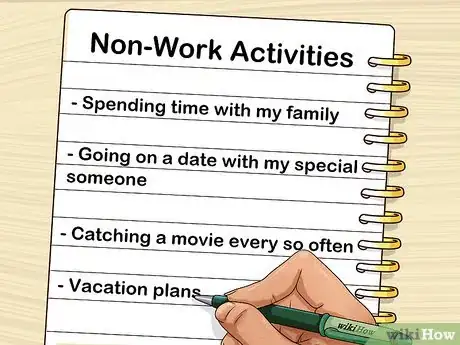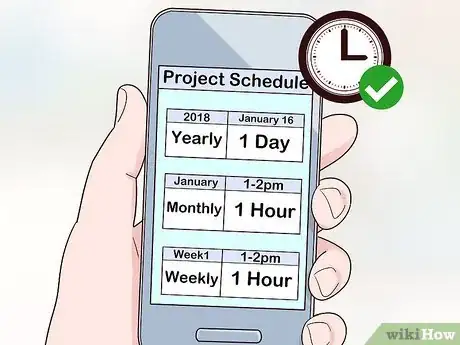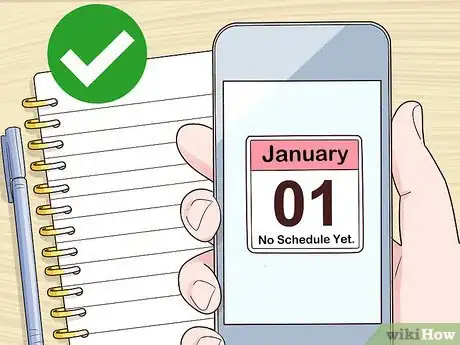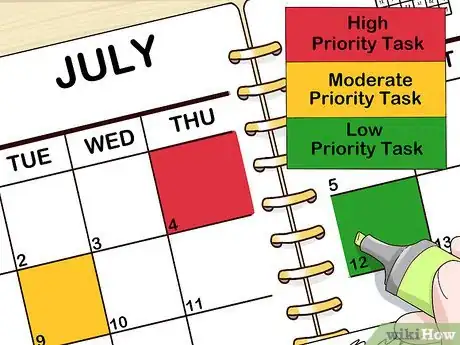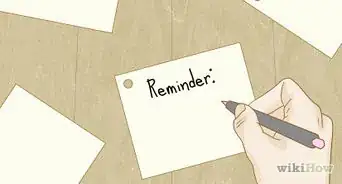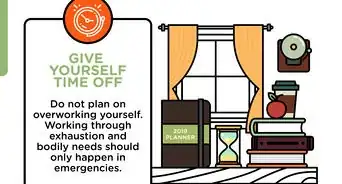This article was co-authored by Michelle Shahbazyan, MS, MA. Michelle Shahbazyan is the Founder of The LA Life Coach, a concierge life, family, and career coaching service based in Los Angeles, California. She has over 10 years of experience with life coaching, consulting, motivational speaking, and matchmaking. She has a BA in Applied Psychology and an MS in Building Construction and Technology Management from Georgia Tech University, and a MA in Psychology with an emphasis on Marriage and Family Therapy from Phillips Graduate University.
This article has been viewed 118,831 times.
Time blocking is a type of scheduling that can help you manage your time better. To learn how to limit distractions and get things done faster with time block scheduling, read on!
Steps
Breaking down Your Workload
-
1
-
2Make a list of your typical workday tasks. Beyond the bigger stuff, you've probably got tons of other things going on that take up time every day. Write down these smaller tasks, noting about how long they usually take you to complete.[3]
- This could be answering emails or phone calls, promoting your company on social media, or posting an online comment about a book you're reading for your English class.
Advertisement -
3Make a list of your non-work activities. Think about what's important to you that's not work-related. This could be spending time with your family, going on a date with your special someone, or catching a movie every so often. Don't forget to also note big vacations![4]
Setting up the Schedule
-
1Plan to finish tasks, not work by the clock. Don't think about your workday as revolving around a clock. Instead, you should have several tasks that you set aside blocks of time to finish. Once you finish the tasks, you're done with work.[5]
- So rather than having a random to-do list that you have to finish before five o'clock, you'll have several blocks of time dedicated to completing individual projects one at a time.
- This doesn't mean you won't still be in a routine. Your blocks of time should be consistent from day to day.
-
2Block time for your hardest tasks when you're most productive. For most people, this will be right at the start of the workday. Dedicate a minimum of one hour to your highest-priority task. Start there, and then move through to the next time block in order of priority.[6]
- For example, if you know you work best before noon, plan to spend the block before your lunch break on your toughest task -- perhaps a budget proposal that's due in six months.
- Usually, time blocks aren't effective if they last more than a few hours.
-
3Block out the rest of the day by tasks. Schedule the rest of the day in shorter blocks dedicated to one task per block. These blocks should go in order of priority, since your energy level will probably go down over the course of the day. You'll also feel better if you know the hard stuff is done as early as possible.
- If you're the type of person whose energy increases as the day goes on, feel free to reverse the order of the tasks you're tackling. Make the schedule work for you!
- So, for example, if you've handled the hardest task first thing in the morning, break the afternoon down into two, three, or four blocks of time (each lasting an hour or two). The first could be for mapping out future sales strategies, the next for meetings with your team, and so on.
- Everyone's schedule will be different. You'll need to decide what's most important for your work on any given day.[7]
-
4Handle lowest priority items at the end of the day. Address less complicated issues late in the day, when you're tired and probably not feeling particularly productive or creative. These should be tasks that are relatively mindless or monotonous, and don't require a lot of critical thinking.
- Lower priority tasks could include answering emails and calls. You should plan to do this at the same time each day. Let your coworkers know that these are your “office hours,” and you'll always be responsive to emails and calls during that time block.
-
5Add in blocks for planning. Since time blocking is all about scheduling and advanced planning, you need to make time for that too! Set aside one day each year for annual planning (for long-term projects), an hour each month for monthly planning, and an hour each week for weekly planning.[8]
- This means that all your scheduling and writing of to-do lists should occur only in the blocks you've set aside for planning.
-
6Don't forget to reserve time off. Schedule in time to spend with your family and friends each week. Input a large block of time for a big vacation once or twice per year. Remember to also add blocks for working on your house or cleaning.[9]
-
7Schedule an empty block of time each day for flexibility. This doesn't have to be a huge block. Try having a 30-minute block and increase it if you need to. This can be for tasks that overflow beyond their set blocks, or unexpected disasters you have to deal with right away.[10]
Following through in the Long Term
-
1Use a paper or digital calendar to keep track of your blocks. Especially when you first start out, it may be hard to keep track of your different blocks. Use a calendar app on your smartphone with timers and reminders. You can also buy a large desk calendar and label the days, months, and year with your blocks.[11]
-
2Color-code your calendar. Both paper and digital options give you the ability to color-code, and you should take advantage. Label different time blocks in set colors. You can even match this to priority level. Red can be high-priority tasks, yellow moderate, and green low.
- For paper, use different colored markers or highlighters. For digital, check the settings on the app or software you're using and follow the instructions to color-code.
-
3Be open about your schedule with coworkers and family. In order for your schedule to work, other people in your life need to learn to respect it. Consider sending an email to your coworkers about your time blocks so they know what to expect from your workday. You can also tell your family about your plans, and ask them to help you stick to it.
- Don't expect everyone to mold their schedules to yours. Before you finalize your blocks, make sure your time blocking doesn't cause scheduling problems for someone you work or live with.
-
4Commit to the routine for at least a month. Like any routine, you need to commit to time blocking to make it effective. It'll probably feel overly rigid at first, but give it at least thirty workdays. By the end of the month, you'll be able to tell whether it's helped you become more productive.[12]
-
5
-
6Track your productivity to see if time blocking works for you. Time blocking may not be for everyone. Make sure it works for you by seeing if you become more productive once you organize your schedule this way. To track your productivity, note how long tasks usually take you at the beginning and the end of the first month after you put the new schedule in place.
Expert Q&A
-
QuestionHow can I manage my time more effectively?
 Michelle Shahbazyan, MS, MAMichelle Shahbazyan is the Founder of The LA Life Coach, a concierge life, family, and career coaching service based in Los Angeles, California. She has over 10 years of experience with life coaching, consulting, motivational speaking, and matchmaking. She has a BA in Applied Psychology and an MS in Building Construction and Technology Management from Georgia Tech University, and a MA in Psychology with an emphasis on Marriage and Family Therapy from Phillips Graduate University.
Michelle Shahbazyan, MS, MAMichelle Shahbazyan is the Founder of The LA Life Coach, a concierge life, family, and career coaching service based in Los Angeles, California. She has over 10 years of experience with life coaching, consulting, motivational speaking, and matchmaking. She has a BA in Applied Psychology and an MS in Building Construction and Technology Management from Georgia Tech University, and a MA in Psychology with an emphasis on Marriage and Family Therapy from Phillips Graduate University.
Matchmaker, The LA Life Coach Take notice of the small things you do every day, like scrolling social media or laying in bed snoozing several times or binge-watching TV episode after episode. If you add it all up, a lot of time gets lost doing those small things. Try to use that time to complete the things that you want to complete and achieve the things that you want to achieve.
Take notice of the small things you do every day, like scrolling social media or laying in bed snoozing several times or binge-watching TV episode after episode. If you add it all up, a lot of time gets lost doing those small things. Try to use that time to complete the things that you want to complete and achieve the things that you want to achieve.
References
- ↑ Michelle Shahbazyan, MS, MA. Life Coach. Expert Interview. 18 March 2020.
- ↑ https://www.entrepreneur.com/article/226231
- ↑ https://toggl.com/time-blocking
- ↑ http://www.lifehack.org/articles/productivity/scheduling-time-blocks.html
- ↑ https://www.entrepreneur.com/article/226231
- ↑ https://mcgraw.princeton.edu/sites/mcgraw/files/media/effective-time-management.pdf
- ↑ Michelle Shahbazyan, MS, MA. Life Coach. Expert Interview. 18 March 2020.
- ↑ https://www.entrepreneur.com/article/226231
- ↑ https://www.entrepreneur.com/article/226231
- ↑ https://www.fastcompany.com/3069293/could-time-blocking-replace-your-to-do-list
- ↑ http://www.lifehack.org/articles/productivity/scheduling-time-blocks.html
- ↑ https://mcgraw.princeton.edu/sites/mcgraw/files/media/effective-time-management.pdf
- ↑ Michelle Shahbazyan, MS, MA. Life Coach. Expert Interview. 18 March 2020.
- ↑ https://www.fastcompany.com/3069293/could-time-blocking-replace-your-to-do-list
About This Article
To time block, make a list of your typical workday tasks and how long they usually take you to complete. You’ll also want to make a list of your non-work activities and any large projects of breaks you have coming up. Once your lists are complete, block time for your hardest tasks when you’re most productive, which is often at the start of the workday. Spend at least 1 hour on your highest-priority task. Then, use your next time block on your next highest priority item, moving through the day in this manner. To learn how to use a digital calendar to keep track of time blocks, keep reading!


